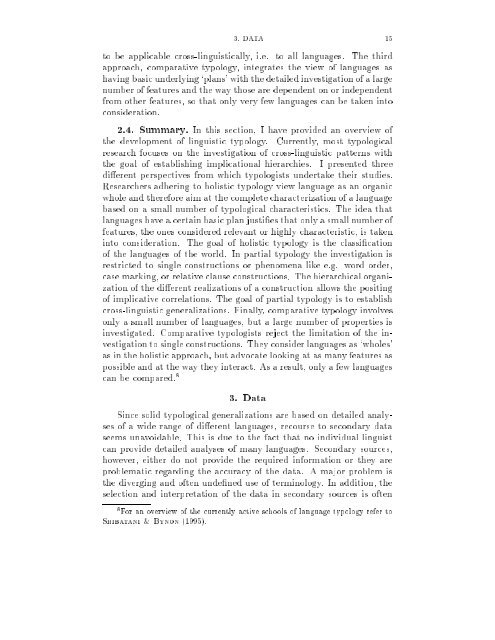Perception verb complements in Akatek, a Mayan language
Perception verb complements in Akatek, a Mayan language
Perception verb complements in Akatek, a Mayan language
Create successful ePaper yourself
Turn your PDF publications into a flip-book with our unique Google optimized e-Paper software.
3. DATA 15<br />
to be applicable cross-l<strong>in</strong>guistically, i.e. to all <strong>language</strong>s. The third<br />
approach, comparative typology, <strong>in</strong>tegrates the view of <strong>language</strong>s as<br />
hav<strong>in</strong>g basic underly<strong>in</strong>g `plans' with the detailed <strong>in</strong>vestigation of a large<br />
number of features and the way those are dependent on or <strong>in</strong>dependent<br />
from other features, so that only very few <strong>language</strong>s can be taken <strong>in</strong>to<br />
consideration.<br />
2.4. Summary. In this section, I have provided an overview of<br />
the development of l<strong>in</strong>guistic typology. Currently, most typological<br />
research focuses on the <strong>in</strong>vestigation of cross-l<strong>in</strong>guistic patterns with<br />
the goal of establish<strong>in</strong>g implicational hierarchies. I presented three<br />
di erent perspectives from which typologists undertake their studies.<br />
Researchers adher<strong>in</strong>g to holistic typology view <strong>language</strong> as an organic<br />
whole and therefore aim at the complete characterization of a <strong>language</strong><br />
based on a small number of typological characteristics. The idea that<br />
<strong>language</strong>s have a certa<strong>in</strong> basic plan justi es that only a small number of<br />
features, the ones considered relevant or highly characteristic, is taken<br />
<strong>in</strong>to consideration. The goal of holistic typology is the classi cation<br />
of the <strong>language</strong>s of the world. In partial typology the <strong>in</strong>vestigation is<br />
restricted to s<strong>in</strong>gle constructions or phenomena like e.g. word order,<br />
case mark<strong>in</strong>g, or relative clause constructions. The hierarchical organization<br />
of the di erent realizations of a construction allows the posit<strong>in</strong>g<br />
of implicative correlations. The goal of partial typology is to establish<br />
cross-l<strong>in</strong>guistic generalizations. F<strong>in</strong>ally, comparative typology <strong>in</strong>volves<br />
only a small number of <strong>language</strong>s, but a large number of properties is<br />
<strong>in</strong>vestigated. Comparative typologists reject the limitation of the <strong>in</strong>vestigation<br />
to s<strong>in</strong>gle constructions. They consider <strong>language</strong>s as `wholes'<br />
as <strong>in</strong> the holistic approach, but advocate look<strong>in</strong>g at as many features as<br />
possible and at the way they <strong>in</strong>teract. As a result, only a few <strong>language</strong>s<br />
can be compared. 8<br />
3. Data<br />
S<strong>in</strong>ce solid typological generalizations are based on detailed analyses<br />
of a wide range of di erent <strong>language</strong>s, recourse to secondary data<br />
seems unavoidable. This is due to the fact that no <strong>in</strong>dividual l<strong>in</strong>guist<br />
can provide detailed analyses of many <strong>language</strong>s. Secondary sources,<br />
however, either do not provide the required <strong>in</strong>formation or they are<br />
problematic regard<strong>in</strong>g the accuracy of the data. A major problem is<br />
the diverg<strong>in</strong>g and often unde ned use of term<strong>in</strong>ology. In addition, the<br />
selection and <strong>in</strong>terpretation of the data <strong>in</strong> secondary sources is often<br />
8 For an overview of the currently active schools of <strong>language</strong> typology refer to<br />
Shibatani & Bynon (1995).

















